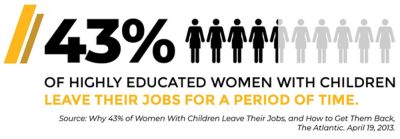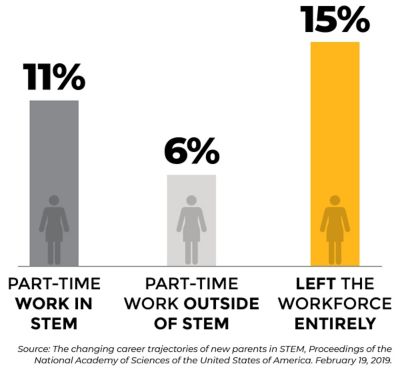-
Ansys is committed to setting today's students up for success, by providing free simulation engineering software to students.
-
Ansys is committed to setting today's students up for success, by providing free simulation engineering software to students.
-
Ansys is committed to setting today's students up for success, by providing free simulation engineering software to students.
-
Contact Us -
Careers -
Students and Academic -
For United States and Canada
+1 844.462.6797
ANSYS BLOG
March 8, 2022
Women in Technology: Breaking the Bias Against Working Mothers
In 2021, 50.04%1 of the United States workforce were women, up from 49.7% the previous year. Of that 50%, one third2 have children under 18. Working mothers have what can seem like two fulltime jobs: their day job and caregiving. Nearly 22%3 of highly educated women are fulltime caregivers, while only 1.5%3 of men are stay at home dads. And COVID-19 hasn’t helped. Due to the pandemic, 33%4 of working mothers considered reducing their workload or leaving work altogether.

But with a strong support system from friends, family, and employers, working mothers can excel at work and at home without sacrificing one for the other.
A Common Theme
We sat down with a few women from Ansys to discuss the "Break the Bias" theme of International Women’s Day 2022. There was a common theme to the conversations: expectations about women in engineering.
“It’s a weird notion that women have to give up themselves. People shouldn’t be putting this on them,” Soma Chakrabarti, manager of education development at Ansys, explains. “I mean, a lot of women don't come to engineering because they think they will not get married. But that’s not true.”
Chakrabarti attended the University of Calcutta in India where she earned her bachelor’s degree and a master’s degree in chemical technology. She received her doctorate in biochemical engineering from the Indian Institute of Technology, Delhi. “During this entire time, many of my relatives asked my father: ‘Why you are not getting your daughter married. What is she doing?’”
The Expectations of Working Moms
Maintaining proper work life balances is hard for anyone, let alone working mothers. In a viral social media post, Buckley Friedberg5 explains, with humor, all the things mothers are expected to be:
- Santa Claus
- The Easter Bunny
- The Tooth Fairy
- The birthday planner
- The poop doula
- The finder of lost things
- The moderator of fights
Not only is mom expected to have a Pinterest-like household, she’s expected to excel in her career. But that’s difficult when women create a living human being, watch it grow for a few months, or even weeks, and then go back to work fulltime. The emotional and physical exhaustion of being a working mom weighs heavily on their shoulders. With all these expectations, it’s no surprise that 43%6 of highly educated women with children leave their jobs for a period of time.

Women in STEM: A Double Whammy
Roughly 35%7 of STEM students, graduate and undergraduate, are women. Only 12.5%8 of all aerospace engineers are women.
“You are probably the only woman in the room,” Swati Saxena, technical account manager at Ansys, explains. “We don't have that many female graduate students in engineering.”
A study9 conducted from 2003 to 2010 found that “new mothers switched to either part-time work in STEM (11%), part-time work outside of STEM (6%), or left the workforce entirely (15%) by 2010.” The study also found that these trends occur regardless of discipline, race, and other demographic factors, suggesting that it is a combination of the duties of motherhood and the demand of STEM careers that force mothers to choose.
Saxena has her bachelor’s, master’s, and doctorate in aerospace engineering. She currently supports some of Ansys’ major enterprise federal aerospace and defense accounts. She explained that one challenge women in engineering face didn’t occur to her until she had her first child two years ago. “Women go through much more,” she says. “They definitely have much more responsibility for the baby and so on.”

Many women switch to part-time jobs outside of STEM or leave the workforce when they have children.
How to Break the Bias of Women in Engineering
The solution is to support women in whatever decision they make; whether that be a working mom, a stay-at-home mom, or not a mom at all.
Christy Weng, license compliance manager at Ansys, explained that her greatest accomplishment was having her daughter. “You have to balance the two: work and motherhood,” she says, “and you need a strong support system to do that.”
All three women highlighted that having a strong support system through their family, friends, and workplace has helped them succeed. Chakrabarti suggests that some societal and cultural changes also need to be made to really support working mothers.
“One of the things that I see here is that mothers get a long maternity leave,” says Chakrabarti, who currently lives in the United Kingdom. “Even the fathers are given paternity leave.”
“We have to give women enough room and opportunities to have that work-life balance and not judge them,” Saxena adds. “I was fortunate enough to have very, very strong support from my management to be able to work a flexible schedule and also be able to take care of the family at the same time.”
This International Women’s Day, we want to break the bias that working women have to choose between working in a career they love or caring for their families. At Ansys, we pride ourselves on the fact that men and women can do both successfully. For more information about how Ansys supports its employees visit the careers page.
Women at Ansys describe how they found success in the workplace.
References
- The Employment Situation - Bureau of Labor Statistics, U.S. Department of Labor.
- About Two-Thirds of the 23.5 Million Working Women with Children Under 18 Worked Full-Time in 2018, U.S. Census Bureau. May 8, 2020.
- A quantum leap for gender equality: For a better future of work for all, International Labour Organization. March 7, 2019.
- For mothers in the workplace, a year (and counting) like no other, McKinsey & Company. May 5, 2021.
- Mom's viral post on society's expectations of working moms gets standing ovation on Facebook, Good Morning America. April 23, 2019.
- Why 43% of Women With Children Leave Their Jobs, and How to Get Them Back, The Atlantic. April 19, 2013.
- Digest of education Statistics, National Center for Education Statistics.
- Aerospace Engineer Statistics and Facts in the US, Zippia.
- The changing career trajectories of new parents in STEM, Proceedings of the National Academy of Sciences of the United States of America. February 19, 2019.
See What Ansys Can Do For You
See What Ansys Can Do For You
Contact us today
Thank you for reaching out!
We’re here to answer your questions and look forward to speaking with you. A member of our Ansys sales team will contact you shortly.











